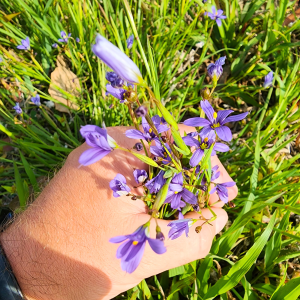A handful of the “lawn ornaments” that will be featured in this blog series. Top row (left to right): Sunshine Powderpuff, Perennial Peanut, Frogfruit, and Fleabane. Bottom row (left to right): Manyflower Pennywort, Bay Lobelia, Florida Snow, and Blue-Eyed Grass.
Welcome to our Lawn Ornament blog series, where we explore the plethora of micro-plants that can help create a biodiverse, predominantly green, yet also delightfully colorful lawn that requires much less maintenance than a traditional grass lawn.
Many homeowners find it difficult and costly to maintain a “traditional” lawn, one largely dominated by a single grass cultivar. Embracing a biodiverse landscape can ease the frustration and save money, with the added bonus of providing ecological benefits. This “Lawn Ornament” series will provide a road map to that goal. Along the way, we’ll showcase volunteer “weeds” and commercially available ground covers that can improve upon the biodiversity of our lawns. We will also offer you tips and techniques to adopt and embrace this biodiverse approach. Breaking free from tradition, we can transform yards and neighborhoods to vibrant, beautiful mixed-mowable ecosystems.
Make sure to check out the Starter Guide: Embracing Lawn Ornaments: A Starter Guide
This plant is one that peaks in spring and is a prime example of the importance of No Mow March.
Blue-Eyed Grass

In the midst of your traditional lawn, why not introduce a touch of native, wild beauty? Enter the blue-eyed grass (Sisyrinchium angustifolium), a charming member of the iris family that masquerades as turf grass but surprises with bursts of vibrant, beneficial blooms. As spring unfolds its splendor, this delightful plant transforms into a lawn ornament adorned with its wildflowers, adding a touch of whimsy and ecological value to your mixed-mowable landscape.
A Small Wonder of the Iris Family
Blue-eyed grass (Sisyrinchium angustifolium) might deceive you at first glance, resembling a typical grass found in a traditional lawn. However, its petite stature and slender leaves give it away as a member of the iris family. What truly sets it apart is its ability to produce stunning flowers that adorn the landscape with hues ranging from azure to indigo, making it a standout addition to any mixed-mowable landscape.
Crucial for Pollinators
As early spring unfolds, blue-eyed grass bursts into bloom, offering a vital food source for pollinators, especially native bee species. Its nectar-rich flowers beckon bees, butterflies, and other beneficial insects, ensuring a thriving ecosystem within your garden. By welcoming blue-eyed grass into your landscape, you’re not just adding beauty; you’re supporting biodiversity and fostering a healthy environment for all creatures great and small.
Adaptable and Easy to Propagate

One of the remarkable traits of blue-eyed grass is its adaptability to various growing conditions. While it thrives in moist soils, it can also endure drier environments, making it suitable for a range of landscapes, from garden beds to roadside edges. Furthermore, propagating blue-eyed grass is a breeze, whether through seeds or division. After blooming, collect the darkened, wrinkled seed capsules to sow new plants or divide existing clumps to expand your blue-eyed grass patch. With minimal effort, you can create a flourishing sea of blue-eyed grass in your outdoor oasis.
Ethnobotanical Uses
Beyond its aesthetic appeal and ecological benefits, blue-eyed grass has a rich history of ethnobotanical uses. Native Americans utilized its roots to brew teas for treating ailments such as stomachaches and worms. The plant also served as a natural laxative, particularly beneficial for children suffering from diarrhea. However, a word of caution: while blue-eyed grass holds historical ethnobotanical potential, it’s crucial to exercise extreme caution when foraging wild plants. Mistaking similar-looking species could have severe consequences, as some may be toxic or even lethal. Additionally, it’s favored growth habitat, along roadways, doesn’t make for the safest soil, with unknown chemicals and heavy metals likely contaminating wild plants.
Conclusion
In essence, blue-eyed grass is not just a mere lawn ornament; it’s a testament to the wonders of nature and the intricate web of life that surrounds us. By embracing this unassuming yet enchanting plant, you’re not only enhancing the beauty of your landscape but also nurturing biodiversity and preserving centuries-old traditions of herbal medicine. So, why not invite the magic of blue-eyed grass into your garden this spring?

Resources
- UF/IFAS Gardening Solutions on Blue-Eyed Grass: https://gardeningsolutions.ifas.ufl.edu/plants/ornamentals/blue-eyed-grass.html
- UF/IFAS EDIS on Blue-Eyed Grass: https://edis.ifas.ufl.edu/publication/ag401
- Florida Native Plant Society on Blue-Eyed Grass: https://www.fnps.org/plant/sisyrinchium-angustifolium
- Florida Wildflower Foundation on Blue-Eyed Grass: https://www.flawildflowers.org/flower-friday-sisyrinchium-angustifolium/
During the preparation of this work, the author used ChatGPT to help build the blog post. After using this tool/service, the author reviewed and edited the content, and takes full responsibility for the content of the publication.
 7
7

